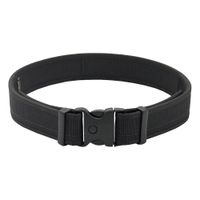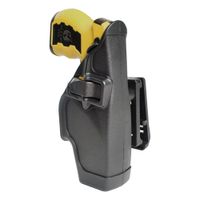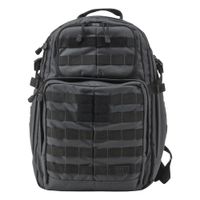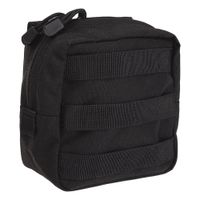Call +(254) 703 030 000 / 751 483 999 / 721 704 777
- Home
- Security
- Military Tactical Public Security Equipment
- Duty Gear Holsters Tactical Backpacks
.....Read More
Frequently Asked Questions
What is the best duty gear for law enforcement?
The best duty gear for law enforcement should prioritize safety, functionality, and comfort. Essential components include:
1. **Duty Belt**: A high-quality, durable duty belt is crucial. It should be made of strong materials like nylon or leather and designed to distribute weight evenly to prevent back strain.
2. **Holster**: A secure, quick-access holster is vital. Options like Level II or III retention holsters provide added security while allowing for rapid weapon access.
3. **Body Armor**: Lightweight, flexible body armor with a high protection level (NIJ Level IIIA or higher) is essential for officer safety against ballistic threats.
4. **Handcuffs**: Durable, easy-to-use handcuffs made from stainless steel or aluminum are necessary for restraining suspects.
5. **Flashlight**: A compact, high-lumen flashlight with a long battery life is crucial for visibility in low-light conditions.
6. **Radio and Communication Devices**: Reliable, clear communication devices are essential for coordination and safety.
7. **Taser or Stun Gun**: Non-lethal options like tasers provide an alternative to firearms in subduing suspects.
8. **Pepper Spray**: A compact canister of pepper spray offers a non-lethal means of defense.
9. **First Aid Kit**: A compact first aid kit with essential medical supplies can be crucial in emergencies.
10. **Gloves**: Cut-resistant, tactical gloves protect hands while allowing dexterity.
11. **Boots**: Comfortable, durable boots with good ankle support and slip-resistant soles are necessary for long hours on duty.
12. **Body Camera**: A reliable body camera for recording interactions can provide accountability and evidence.
Selecting gear that meets these criteria ensures law enforcement officers are well-equipped to handle various situations effectively and safely.
How do I choose the right holster for my firearm?
To choose the right holster for your firearm, consider the following factors:
1. **Purpose**: Determine the primary use—concealed carry, open carry, competition, or duty use. This will influence the type of holster you need.
2. **Firearm Fit**: Ensure the holster is specifically designed for your firearm model for a secure fit. A well-fitted holster will provide better retention and accessibility.
3. **Carry Position**: Decide on the carry position—inside the waistband (IWB), outside the waistband (OWB), appendix, shoulder, ankle, or pocket. Each position offers different levels of concealment and comfort.
4. **Material**: Choose between leather, Kydex, nylon, or hybrid materials. Leather offers comfort and durability, Kydex provides rigidity and retention, nylon is lightweight and affordable, and hybrids offer a balance of comfort and retention.
5. **Retention**: Consider the level of retention needed. Passive retention relies on the holster's shape, while active retention includes mechanisms like thumb breaks or retention straps for added security.
6. **Comfort**: Ensure the holster is comfortable for extended wear. Consider factors like weight distribution, padding, and adjustability.
7. **Accessibility**: The holster should allow for a quick and smooth draw. Test the draw angle and ensure it aligns with your natural motion.
8. **Concealment**: For concealed carry, ensure the holster minimizes printing and is easily concealable under your typical clothing.
9. **Quality and Durability**: Invest in a high-quality holster from reputable manufacturers to ensure longevity and reliability.
10. **Legal Considerations**: Be aware of local laws and regulations regarding holster types and carry methods.
11. **Personal Preference**: Ultimately, personal comfort and preference play a significant role. Try different options to find what works best for you.
What features should I look for in a tactical backpack?
When selecting a tactical backpack, consider the following features:
1. **Material and Durability**: Look for high-quality, durable materials like 500D or 1000D nylon or Cordura, which offer resistance to wear, tear, and water.
2. **Capacity and Size**: Choose a size that fits your needs, typically ranging from 20L to 60L. Ensure it can carry all your gear without being too bulky.
3. **Compartments and Organization**: Multiple compartments and pockets help organize gear efficiently. Look for a main compartment, secondary compartments, and smaller pockets for easy access.
4. **MOLLE System**: Modular Lightweight Load-carrying Equipment (MOLLE) webbing allows for customization and attachment of additional pouches and gear.
5. **Comfort and Fit**: Padded shoulder straps, a sternum strap, and a waist belt distribute weight evenly. Adjustable straps ensure a snug fit.
6. **Hydration Compatibility**: A compartment for a hydration bladder with a hose port is essential for staying hydrated on the move.
7. **Zippers and Buckles**: Heavy-duty, reliable zippers and buckles, such as YKK zippers, ensure longevity and security.
8. **Ventilation**: A ventilated back panel helps reduce sweating and increases comfort during extended use.
9. **Accessibility**: Easy access to compartments and gear is crucial. Look for clamshell openings or side zippers for quick entry.
10. **Reinforced Stitching**: Double or triple stitching in high-stress areas enhances durability.
11. **Weather Resistance**: Water-resistant materials or a rain cover protect contents from the elements.
12. **Color and Camouflage**: Depending on your needs, choose a color or pattern that suits your environment, such as camo for outdoor use.
13. **Weight**: A lightweight design is preferable to avoid unnecessary strain.
14. **Price and Brand Reputation**: Consider reputable brands known for quality and durability, balancing cost with features.
How do I properly set up a duty belt?
To properly set up a duty belt, follow these steps:
1. **Select the Right Belt**: Choose a sturdy, high-quality belt that fits your waist size and can support the weight of your gear.
2. **Positioning**: Wear the belt at your natural waistline. Ensure it is snug but not too tight to allow for comfort and mobility.
3. **Belt Keepers**: Use belt keepers to secure the duty belt to your inner belt. This prevents shifting and maintains stability.
4. **Holster Placement**: Position your holster on your dominant side, typically between the 2 o'clock and 4 o'clock positions for right-handed users. Ensure it allows for a smooth draw.
5. **Magazine Pouches**: Place magazine pouches on your support side, usually around the 9 o'clock position, for easy access with your non-dominant hand.
6. **Handcuff Case**: Position the handcuff case near the center of your back or slightly to the side for easy reach with either hand.
7. **Radio Holder**: Place the radio holder on your support side, often near the front, for quick access and communication.
8. **Baton Holder**: Position the baton holder on your dominant side, slightly behind the holster, for a swift draw.
9. **Flashlight Holder**: Place the flashlight holder on your support side, near the front, for easy access in low-light situations.
10. **Taser and Other Gear**: If carrying a Taser or other equipment, position it on your support side, ensuring it does not interfere with other gear.
11. **Balance and Comfort**: Distribute the weight evenly around the belt to prevent discomfort and fatigue. Adjust the placement of items as needed for balance.
12. **Regular Checks**: Periodically check the belt for wear and ensure all equipment is secure and accessible.
What are the benefits of using tactical pouches?
Tactical pouches offer several benefits, enhancing both functionality and convenience for users in various scenarios. Firstly, they provide organized storage, allowing users to efficiently categorize and access essential gear, tools, or supplies. This organization is crucial in high-pressure situations where quick access can be vital.
Secondly, tactical pouches are highly versatile. They can be attached to backpacks, belts, or vests using MOLLE (Modular Lightweight Load-carrying Equipment) systems, making them adaptable to different needs and environments. This modularity allows users to customize their loadout based on specific missions or activities, whether in military operations, hiking, or everyday carry.
Durability is another significant advantage. Tactical pouches are typically constructed from robust materials like nylon or Cordura, which are resistant to wear, tear, and weather conditions. This ensures that the contents are protected and the pouch remains functional over time, even in harsh environments.
Moreover, tactical pouches enhance mobility. By distributing weight evenly and keeping essential items within easy reach, they reduce the need for larger, bulkier bags. This streamlined approach allows for greater freedom of movement, which is crucial in dynamic situations.
Additionally, tactical pouches often feature specialized compartments or features, such as hydration bladder compatibility, radio holders, or medical kit organization. These specialized designs cater to specific needs, enhancing the efficiency and effectiveness of the user.
Finally, tactical pouches contribute to safety and preparedness. By ensuring that critical items like first aid kits, communication devices, or navigation tools are readily accessible, users can respond swiftly to emergencies or changing conditions, thereby increasing their overall readiness and security.
How do I maintain and clean my duty gear?
To maintain and clean your duty gear effectively, follow these steps:
1. **Regular Inspection**: Frequently check your gear for wear and tear. Look for frayed edges, broken buckles, or any signs of damage that could compromise functionality.
2. **Cleaning**:
- **Leather Gear**: Use a damp cloth to wipe off dirt and dust. Apply a leather cleaner or saddle soap for deeper cleaning. Condition with a leather conditioner to keep it supple and prevent cracking.
- **Nylon Gear**: Hand wash with mild soap and water. Use a soft brush to scrub away stubborn dirt. Rinse thoroughly and air dry.
- **Metal Parts**: Clean with a metal polish or a damp cloth. Ensure all moving parts are lubricated to prevent rust and ensure smooth operation.
3. **Storage**: Store gear in a cool, dry place away from direct sunlight to prevent fading and deterioration. Use a gear bag to keep items organized and protected.
4. **Maintenance**:
- **Fasteners and Buckles**: Check for functionality and replace if necessary. Ensure they are free of debris and operate smoothly.
- **Velcro**: Clean by removing lint and debris with a fine-tooth comb or a Velcro brush to maintain its grip.
5. **Rotation**: If possible, rotate gear to allow for even wear and extend the lifespan of each item.
6. **Professional Servicing**: For complex gear like firearms or electronic equipment, seek professional servicing to ensure they remain in optimal condition.
7. **Documentation**: Keep a log of maintenance activities to track the condition and service history of your gear.
By following these steps, you can ensure your duty gear remains in top condition, enhancing both performance and safety.
What materials are best for durable tactical bags?
The best materials for durable tactical bags include:
1. **Cordura Nylon**: Known for its exceptional durability and resistance to abrasions, tears, and scuffs, Cordura nylon is a popular choice for tactical bags. It is available in various denier ratings, with higher deniers offering increased strength and durability.
2. **Ballistic Nylon**: Originally developed for military body armor, ballistic nylon is a thick, tough, and durable fabric. It provides excellent resistance to wear and tear, making it ideal for tactical bags that require high durability.
3. **Ripstop Nylon**: This fabric is woven with a special reinforcing technique that makes it resistant to tearing and ripping. It is lightweight yet strong, making it suitable for tactical bags that need to be both durable and easy to carry.
4. **Polyester**: While not as durable as nylon, polyester is still a strong material that offers good resistance to UV rays and mildew. It is often used in combination with other materials to enhance the durability of tactical bags.
5. **Kodra Nylon**: Similar to Cordura, Kodra is a durable nylon fabric that offers excellent resistance to abrasions and tears. It is often used in tactical gear for its strength and durability.
6. **Hypalon**: A synthetic rubber known for its resistance to chemicals, temperature extremes, and UV light, Hypalon is often used for reinforcement in high-wear areas of tactical bags.
7. **Leather**: While not as common, leather can be used for tactical bags, offering a classic look with good durability. However, it requires more maintenance to ensure longevity.
8. **YKK Zippers and Duraflex Buckles**: High-quality zippers and buckles are essential for the durability of tactical bags. YKK zippers and Duraflex buckles are renowned for their strength and reliability.
These materials, when combined, create tactical bags that are robust, long-lasting, and capable of withstanding harsh conditions.



